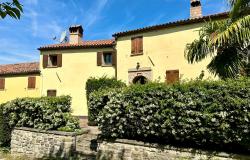Few tourists staying in the Veneto venture north to the Dolomites, but in a couple of hours you can find yourself in another world where the air is cooler, the scenery spectacular and the 21st century hasn’t yet arrived.
The autostrada from Venice takes you to Belluno, the gateway to the Dolomites. It’s a pleasant town of old buildings, and worth a short stop not least because it’s so convenient to get to the centro storico from the large car park at the foot of the hill. There are three covered escalators which take you to the top and you then step out into the most beautiful piazza with the Palazzo dei Rettori on your left and the Duomo on your right. The little Museo Civico opposite is a delight, with a collection of pictures, furniture and archaeological finds. Best of all perhaps is the collection of votive paintings, primitive depictions of miraculous rescues such as horses and carts which overturned and rolled down precipices, only to be saved by the angels.
Onwards and upwards, you drive through the birthplace of Titian, Pieve di Cadore. His family home is still there, including the table where the great artist sat and ate with his brothers and sisters. Most motorists beyond here are heading for Cortina, trendy and expensive for winter sports and a summer escape from the heat of Rome. (There are helicopters which fly from Venice airport directly to Cortina.) I prefer to head the other way, towards where the traditional wooden hay barns which dot the landscape haven’t yet been converted into holiday cottages. There are amazing gorges where you have to lean dangerously forward to see the foaming water far below, and covered bridges to mountain villages.
 Turning left on the small road to Val Visdende, it’s hard to believe that it will take you to any human habitation. The narrow road climbs steeply up the valley, with hairpin bends following a cascading pale blue stream, until you reach a level open space where there is a cluster of traditional wooden houses scattered across the meadow, with neat piles of wood below, and ramps for the hay to be stored on the upper floor. In the only trattoria/bar, Da Plenta, the photos which line the walls give a good indication of how hard life is here. Almost every photograph features a dead stag with huntsmen gathered proudly round it. Needless to say the food on offer reflects what’s available locally: pasta in venison sauce, and giant gnocchi made from breadcrumbs with melted cheese in the middle. Everything is cooked in butter because of course no oil is produced here.
Turning left on the small road to Val Visdende, it’s hard to believe that it will take you to any human habitation. The narrow road climbs steeply up the valley, with hairpin bends following a cascading pale blue stream, until you reach a level open space where there is a cluster of traditional wooden houses scattered across the meadow, with neat piles of wood below, and ramps for the hay to be stored on the upper floor. In the only trattoria/bar, Da Plenta, the photos which line the walls give a good indication of how hard life is here. Almost every photograph features a dead stag with huntsmen gathered proudly round it. Needless to say the food on offer reflects what’s available locally: pasta in venison sauce, and giant gnocchi made from breadcrumbs with melted cheese in the middle. Everything is cooked in butter because of course no oil is produced here.
 The forests are vast, dark and mysterious, full of porcini mushrooms which are picked and sold – several kilos per person every day in season. Even the very elderly are hard at work chopping wood, eking a living out of a harsh climate where patches of snow remain all year round. The work can’t have changed for centuries.
The forests are vast, dark and mysterious, full of porcini mushrooms which are picked and sold – several kilos per person every day in season. Even the very elderly are hard at work chopping wood, eking a living out of a harsh climate where patches of snow remain all year round. The work can’t have changed for centuries.
To the east of the Pieve valley is the Vaiont Dam, once the highest in Europe. In 1963 there was a huge landslide which sent the waters cascading over the dam and destroying the village of Longarone, killing 1908 people. Further up the valley the inhabitants felt threatened by this unstable terrain and abandoned the village of Erto, now a picturesque ghost town where only a few brave souls remained to carry on their lives as before.
When I was there recently, two old ladies  who must both have been in their 80s were manoeuvring a wheelbarrow full of manure down a flight of cobbled steps to their vegetable plot. One pushed, while the other guided the front wheel with a length of string. The squeak of the wheel was the only sound in this silent empty place.
who must both have been in their 80s were manoeuvring a wheelbarrow full of manure down a flight of cobbled steps to their vegetable plot. One pushed, while the other guided the front wheel with a length of string. The squeak of the wheel was the only sound in this silent empty place.
I was left wondering how they survived, and felt privileged to watch a world on the point of vanishing, quite unlike any other part of Italy.













